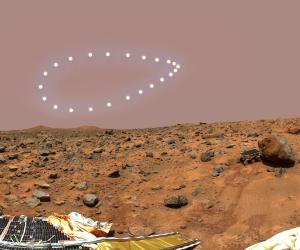Blog
High Noon
15 December 2014
 Tunç Tezel
Tunç TezelNormally we think of “noon” as being when the clock reads 12:00 pm, but in astronomy noon can also mean when the Sun is at its highest point in the sky, or when it transits the meridian (the middle of the sky). These aren’t quite the same thing.
If we consider “noon” to be the time at which the sun is highest in the sky then the time between successive noons is not quite 24 hours. Relative to our clock, our sundial will seem to run a bit fast on some days, and a bit slow on others. Because of this, if we note the position of the Sun at clock noon over the course of a year, it will mark out a figure-8 pattern known as an analemma.
 NASA
NASAThe reason for this pattern is two-fold. For one, Earth’s orbit is not quite a perfect circle, but rather a slight ellipse. For part of the year, it is a bit closer to the Sun than its average distance, and for part of the year it is a bit further away. While the Earth rotates on its axis at essentially a constant rate, the Earth’s speed around the Sun is not constant. Instead, it orbits a bit faster when it is closer to the sun and slower when farther away. Because the Earth is orbiting the Sun, the Earth has to rotate about a degree more than 360 degrees to go from noon to noon. On days when it moves faster, it has to rotate a bit more than that, and on days when it moves more slowly, it has to rotate a bit less. For another, Earth’s rotational axis is tilted relative to its orbital plane. Because of this tilt, the Sun appears higher in the sky during the Summer months and lower in the Winter months. This means from one noon to the next, the Sun is a bit higher or a bit lower depending on the season. The combination of these two factors creates the analemma it’s characteristic shape.
Other planets also see this effect, but because their axial tilts and orbital shapes differ from Earth’s, their analemma have different shapes.